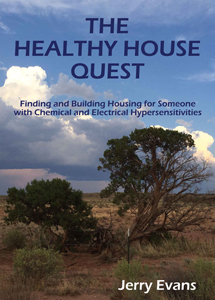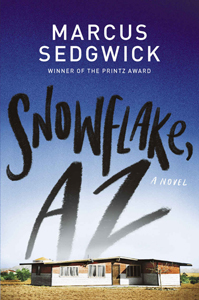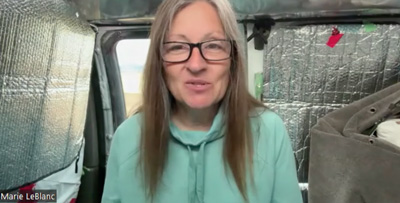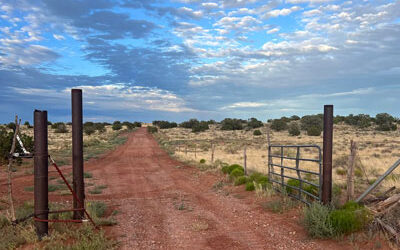Scott writes:
“Jerry Evans’ first book ‘Chemical and Electrical Hypersensitivity —
A Sufferer’s Memoir‘ described his first becoming sick and learning to cope with severe Environmental Illness (EI). His new book ‘The Healthy House Quest: Finding and Building Housing for Someone with Chemical and Electrical Hypersensitivities‘ picks up right where that left off, and focuses on his search for housing that he could tolerate chemically and electrically. Because there was nothing available that was both safe and affordable, Evans successfully built a safe off-grid solar home in rural Snowflake, Arizona.
Evans provides interesting descriptions of the towns of Dolan Springs and Snowflake, AZ, where a number of severe EIs migrate. And he provides a wealth of useful information about searching for safe housing and all stages of construction, along with the many pitfalls to avoid (such as assuming that “green” materials are safe for EIs). The information about safe off-grid solar living should be interesting to anyone with electrical sensitivities.
Evans is an engineer who approaches this challenge with a problem-solving approach that seems logical and systematic. He points out that ‘there is no method and no set of materials that is guaranteed to work for everybody,’ but the information he presents should undoubtedly help anyone interested in environmentally safe housing make healthier choices and avoid common mistakes.”
The second recently published book by a different author, “Snowflake, Az,” is fictional and addresses entirely different themes. Scott shares:
“Young adult (YA) author Marcus Sedgwick has published a new novel called ‘Snowflake, Az that’s actually set in the Snowflake Environmentally Ill (EI) community with EI characters as it’s protagonists. Marcus–who’s a really good guy and entirely sympathetic to EI–visited the community in May of 2018 because he has severe Chronic Fatigue Immune Dysfunction Syndrome (CFIDS) and thought that Multiple Chemical Sensitivity (MCS) might be a part of his illness. After spending a few days there he decided that while he doesn’t have MCS, the Snowflake EI community might provide a good setting through which to expound upon some larger themes related to illness and the environment that have interested him for years.
I’m a member of the EI community in Snowflake, so I began this novel with some trepidation about how our illness and the community would be portrayed. But I needn’t have worried, because–while this is very much a work of fiction–Sedgwick portrays Environmental Illness with great compassion, showing the impact of a poorly-understood (but very real) illness that isolates the characters from the larger world to a small community in rural Arizona.
But ‘Snowflake, Az‘ has much greater ambitions than simply being an exposition of illness. Sedgwick uses the experiences of his EI characters to frame a provocative philosophical and scientific narrative about the state of mankind and what we’re doing to the planet. It was really cool to see ideas that have interested me, like mind-body medicine, tribalism/in-group-out-group dynamics, the role of bacteria in our health and behavior, etc. incorporated into a story that is both entertaining and has a bigger message. I read mainly non-fiction, where the communication of ideas is more direct, but this makes me realize how effective fiction can be for communicating important ideas, and what a special talent it takes to pull that off.”
The author of this second book, Marcus Sedgwick, interviewed my friend Scott about living with environmental illness for his blog ‘Undiagnosis.” Scott did a fantastic job of answering the questions and helping to spread awareness of this life-changing condition.
Please note: Scott has absolutely no financial interest in either of these books.












Great reviews! Beautifully written!